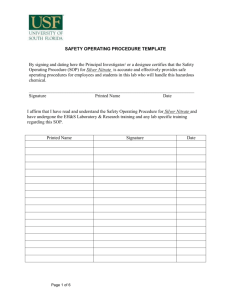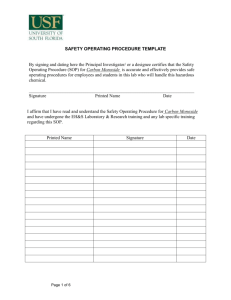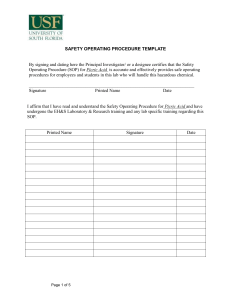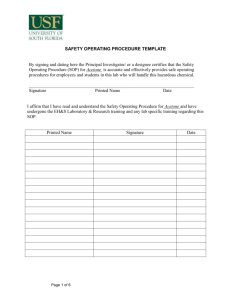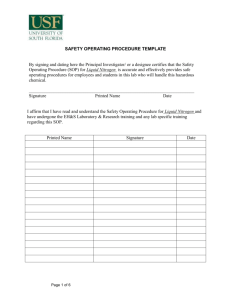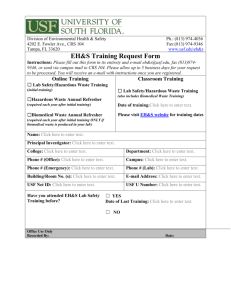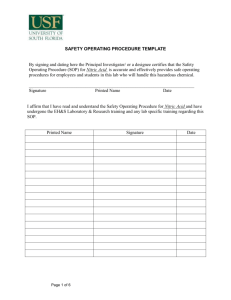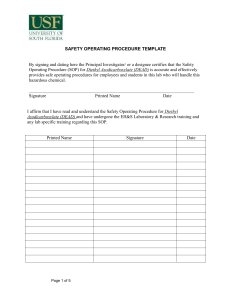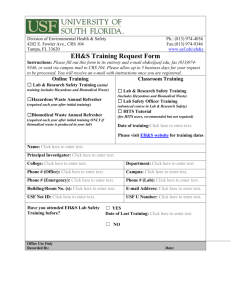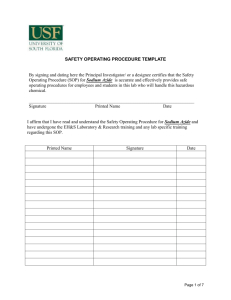Methanol - University of South Florida
advertisement
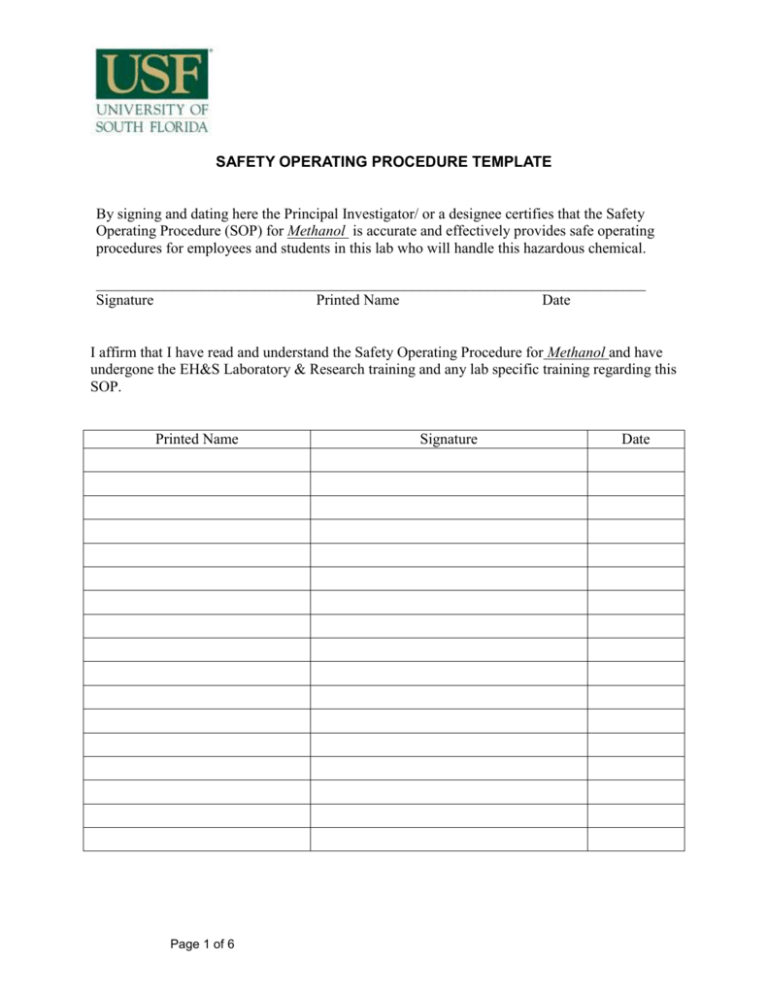
SAFETY OPERATING PROCEDURE TEMPLATE By signing and dating here the Principal Investigator/ or a designee certifies that the Safety Operating Procedure (SOP) for Methanol is accurate and effectively provides safe operating procedures for employees and students in this lab who will handle this hazardous chemical. _________________________________________________________________________ Signature Printed Name Date I affirm that I have read and understand the Safety Operating Procedure for Methanol and have undergone the EH&S Laboratory & Research training and any lab specific training regarding this SOP. Printed Name Page 1 of 6 Signature Date CONTACT INFORMATION: Chemical Name: Methanol 67-56-1 Building/Room Number: Date of Creation/Revision 8/2/2012 Principal Investigator: Emergency Phone number: HAZARD SUMMARY Potential physical and health hazards associated with the use of this chemical include: Appearance: Colorless liquid, Flash Point: 12°C, 53.6°F. Danger! Poison! May be fatal or cause blindness if swallowed. Vapor harmful. Flammable liquid and vapor. Harmful if swallowed, inhaled, or absorbed through the skin. Causes eye, skin, and respiratory tract. irritation. May cause central nervous system depression. Cannot be made non-poisonous. Target Organs: Eyes, nervous system, optic nerve. Potential Health Effects Eye: May cause painful sensitization to light. Methanol is a mild to moderate eye irritant. Inhalation, ingestion or skin absorption of methanol can cause significant disturbance in vision, including blindness. Skin: Causes moderate skin irritation. May be absorbed through the skin in harmful amounts. Prolonged and or repeated contact may cause defatting of skin and dermatitis. Methanol can be absorbed through the skin, producing systemic effects that include visual disturbances. Ingestion: May be fatal or cause blindness if swallowed. Aspiration hazard. Cannot be made nonpoisonous. May cause gastrointestinal irritation with nausea, vomiting and diarrhea. May cause systematic toxicity with acidosis. May cause central nervous system depression, characterized by excitement, followed by headache, dizziness, drowsiness, and nausea. Advanced stages may cause collapse, unconsciousness, coma, and possible death due to failed respiratory failure. May cause cardiopulmonary system effects. Inhalation: Methanol is toxic and can very readily form extremely high vapor concentrations at room temperature. Inhalation is the most common route of occupational exposure. At first, methanol causes CNS depression with nausea, headache, vomiting, dizziness and incoordination. A time period with no obvious symptoms follows (typically 8-24 hrs). This latent period is followed by metabolic acidosis and severevisual effects which may include reduced reactivity and/or increased sensitivity to light, blurred, double and/or snowy vision, and blindness. Depending on the severity of exposure and the promptness of treatment, survivors may recover completely or may have permanent blindness, vision disturbances and/or nervous system effects. Chronic: Prolonged or repeated skin contact may cause dermatitis. Chronic exposure may cause effects similar to those of acute exposure. Methanol is only very slowly eliminated from the body. Because of this slow elimination, methanol should be regarded as a cumulative poison. Though a single exposure may cause no effect, daily exposures may result in the accumulation of a harmful amount. Methanol has Page 2 of 6 produced fetotoxicity in rats and teratogenicity in mice exposed by inhalation to high concentrations that did not produce significant maternal toxicity. SPECIAL HANDLING AND STORAGE REQUIREMENTS Describe special handling and storage requirements for this hazardous chemical in your laboratory, i.e. restricted access to chemical, inclusion of designated areas to limit and minimize possible sources of exposure to these materials. The entire laboratory, a portion of the laboratory, or a laboratory fume hood or bench may be considered a designated area. Special handling and storage requirements for this chemical include: Handling: Wash thoroughly after handling. Remove contaminated clothing and wash before reuse. Ground and bond containers when transferring material. Use spark-proof tools and explosion proof equipment. Avoid contact with eyes, skin, and clothing. Empty containers retain product residue, (liquid and/or vapor), and can be dangerous. Keep container tightly closed. Do not ingest or inhale. Do not pressurize, cut, weld, braze, solder, drill, grind, or expose empty containers to heat, sparks or open flames. Use only with adequate ventilation. Keep away from heat, sparks and flame. Avoid use in confined spaces. Storage: Keep away from heat, sparks, and flame. Keep away from sources of ignition. Store in a cool, dry, well-ventilated area away from incompatible substances. Flammables-area. Keep containers tightly closed. Store in a secure well ventilated poison area, preferably locked up. ENGINEERING AND VENTILATION CONTROLS Include requirements for specific engineering/ventilation controls for this specific chemical, i.e. fume hood. If the process does not permit the handling of such materials in a fume hood, the lab personnel should contact Environmental Health and Safety at x4-4036 for review the adequacy of ventilation measures. Handling processes should be designed to minimize the potential for splash, splatter, or other likely scenarios for accidental contact. The handling of this chemical must be conducted in a fume hood. Additional engineering/ventilation controls for the handling of this chemical include: Engineering Controls: Use explosion-proof ventilation equipment. Facilities storing or utilizing this material should be equipped with an eyewash facility and a safety shower. Use adequate general or local exhaust ventilation to keep airborne concentrations below the permissible exposure limits. PERSONAL PROTECTIVE EQUIPMENT Include specific personal protective equipment required for the handling of this chemical. See the following references: 1. The USF Hazardous Inventory Tracking System (HITS) provides access to MSDS. 2. A glove compatibility chart provides specific information on the type of safety gloves that should be used based on the hazards of specific chemicals. Page 3 of 6 3. The following EH&S webpage provides links to glove manufacturers as well as other PPE selection resources, http://usfweb2.usf.edu/eh&s/labsafety/links.html. At minimum, safety glasses, lab coat, and gloves are to be worn when using this hazardous chemical. Additional PPE Requirements for the handling of this chemical include: appropriate clothing (long pants, close-toed shoes) gloves; indicate type:______________________________ safety goggles □ face shield □ flame-resistant lab coats □ other:__________________________ If the use of an N95, half mask, or full face respirator is requested, the individual and/or their supervisor must first contact Environmental Health & Safety for a consultation to determine if respirator use is necessary. If EH&S determines the use of a respirator is necessary, the individual must participate in the University’s respirator program. This includes a medical evaluation; respirator fit test, and training. Eyes: Wear chemical splash goggles. Skin: Wear butyl rubber gloves, apron, and/or clothing. Clothing: Wear appropriate protective clothing to prevent skin exposure. Respirators: Follow the OSHA respirator regulations found in 29 CFR 1910.134 or European Standard EN 149. Use a NIOSH/MSHA or European Standard EN 149 approved respirator if exposure limits are exceeded or if irritation or other symptoms are experienced. EMERGENCY PROCEDURES If a there is a spill involving an extremely hazardous chemical, emergency responders should be contacted immediately. Dial 911 during and after normal business hours to contact the local emergency responders for your area and provide detail information to the emergency responders including chemical name, volume, hazards, spill location, and any injuries incurred. Building occupants can be notified of a building evacuation through the activation of a fire alarm pull station. Personnel: If lab personnel are exposed to an extremely hazardous chemical, call 911 immediately. Remove any contaminated clothing, and IMMEDIATELY flush contaminated skin with water for at least 15 minutes following any skin contact. For eye exposures, IMMEDIATELY flush eyes with water for at least 15 minutes. Consult MSDS for guidance on appropriate first aid. Where medical attention is required, ensure to bring along MSDS(s) of chemical(s) to aid medical staff in proper diagnosis and treatment. Fire and Emergency Evacuation Procedures: In case of fire or emergency situation, call 911 and or use emergency blue phone immediately to notify the fire emergency services and campus police. Immediately evacuate the building via the nearest exit when the fire alarm is activated. If unable to evacuate due to a disability, shelter in the area of rescue / refuge, typically a stairwell landing, and wait for assistance from drill volunteers or emergency responders. Instruct visitors and students to evacuate and assist them in locating the nearest exit. Do not use elevators to exit the building during an evacuation as they may become inoperable. Carry only those personal belongings that are within the immediate vicinity. Page 4 of 6 Close doors to limit the potential spread of smoke and fire. Terminate all hazardous operations and power off equipment. Close all hazardous materials containers. Remain outside of the building until the building is released for reentry. Do not restrict or impede the evacuation. Convene in the designated grassy gathering area and await instruction from emergency responders or drill volunteers. Avoid parking lots. Report fire alarm deficiencies, (e.g., trouble hearing the alarm) to facilities personnel for repair. Notify evacuation drill volunteers or emergency responders of persons sheltering in the areas of rescue/ refuge. Never assume that an alarm is a “false alarm”. Treat all fire alarm activations as emergencies. Get out of the building! General Information: Use proper personal protective equipment as indicated above. Spills/Leaks: Use water spray to disperse the gas/vapor. Remove all sources of ignition. Absorb spill using an absorbent, non-combustible material such as earth, sand, or vermiculite. Do not use combustible materials such as sawdust. Use a spark-proof tool. Provide ventilation. A vapor suppressing foam may be used to reduce vapors. Water spray may reduce vapor but may not prevent ignition in closed spaces. The Laboratory/Studio and Field Incident Report form is to be completed by the Lab Manager/Teaching Assistant/Instructor for any incident that occurs in any University of South Florida affiliated teaching or research laboratory/studio or field research project. An incident means any unplanned event within the scope of a procedure that causes, or has the potential to cause, an injury or illness and/or damage to equipment, buildings, or the natural environment. Please fill out the online Laboratory/Studio and Field Incident Report form below and submit to Environmental Health & Safety within 24 hours of the incident. Due to medical privacy concerns, no personal identifying information of the person involved in the incident shall be entered or submitted with the form. http://usfweb2.usf.edu/eh&s/labsafety/LabIncident.html WASTE DISPOSAL All chemical waste generated within USF System laboratories are considered hazardous waste and must be disposed of as hazardous waste in accordance with USF Hazardous Waste Management Procedure, the EPA, and the DEP. The USF Hazardous Waste Management Procedure can be found using the following link, http://compass.custhelp.com/app/answers/detail/a_id/1118/kw/hazardous%20waste. Chemical waste generators must determine whether a discarded chemical is classified as a hazardous waste. US EPA guidelines for the classification determination are listed in 40 CFR Parts 261.3. Additionally, waste generators must consult state and local hazardous waste regulations to ensure complete and accurate classification. RCRA P-Series: None listed. RCRA U-Series: CAS# 67-56-1: waste number U154 (Ignitable waste) TRAINING REQUIREMENTS Page 5 of 6 All individuals working with chemicals in USF laboratories must take EH&S’s Laboratory & Research Safety Training. To register for Laboratory & Research Training, please use the following link, http://usfweb2.usf.edu/eh&s/labsafety/tmaterials.html. However, the use of this chemical may warrant additional safety training per the PI, EH&S, or an authorizing unit such as the Biosafety or Radiation Safety programs. Additional training requirements are listed below. Training Requirements: Laboratory & Research Safety Training (EH&S) Research-specific Training (PI) □ Other _____________________________________________________________ PRIOR APPROVALS □ The handling of this chemical requires prior approval from the PI/designee. The handling of this chemical does not require prior approval from the PI/designee. Approval Signature (if required by PI) _________________________________________________________ Page 6 of 6
